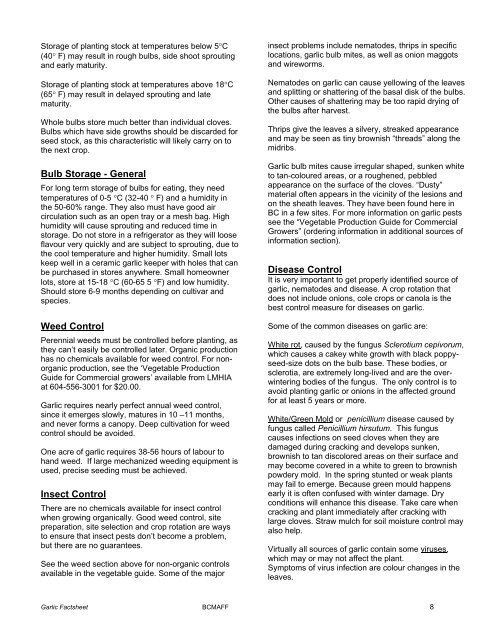Garlic (organic) – Allium sativum - British Columbia ... - Agriculture
Garlic (organic) – Allium sativum - British Columbia ... - Agriculture
Garlic (organic) – Allium sativum - British Columbia ... - Agriculture
Create successful ePaper yourself
Turn your PDF publications into a flip-book with our unique Google optimized e-Paper software.
Storage of planting stock at temperatures below 5°C<br />
(40° F) may result in rough bulbs, side shoot sprouting<br />
and early maturity.<br />
Storage of planting stock at temperatures above 18°C<br />
(65° F) may result in delayed sprouting and late<br />
maturity.<br />
Whole bulbs store much better than individual cloves.<br />
Bulbs which have side growths should be discarded for<br />
seed stock, as this characteristic will likely carry on to<br />
the next crop.<br />
Bulb Storage - General<br />
For long term storage of bulbs for eating, they need<br />
temperatures of 0-5 °C (32-40 ° F) and a humidity in<br />
the 50-60% range. They also must have good air<br />
circulation such as an open tray or a mesh bag. High<br />
humidity will cause sprouting and reduced time in<br />
storage. Do not store in a refrigerator as they will loose<br />
flavour very quickly and are subject to sprouting, due to<br />
the cool temperature and higher humidity. Small lots<br />
keep well in a ceramic garlic keeper with holes that can<br />
be purchased in stores anywhere. Small homeowner<br />
lots, store at 15-18 °C (60-65 5 °F) and low humidity.<br />
Should store 6-9 months depending on cultivar and<br />
species.<br />
Weed Control<br />
Perennial weeds must be controlled before planting, as<br />
they can’t easily be controlled later. Organic production<br />
has no chemicals available for weed control. For non<strong>organic</strong><br />
production, see the ‘Vegetable Production<br />
Guide for Commercial growers’ available from LMHIA<br />
at 604-556-3001 for $20.00.<br />
<strong>Garlic</strong> requires nearly perfect annual weed control,<br />
since it emerges slowly, matures in 10 <strong>–</strong>11 months,<br />
and never forms a canopy. Deep cultivation for weed<br />
control should be avoided.<br />
One acre of garlic requires 38-56 hours of labour to<br />
hand weed. If large mechanized weeding equipment is<br />
used, precise seeding must be achieved.<br />
Insect Control<br />
There are no chemicals available for insect control<br />
when growing <strong>organic</strong>ally. Good weed control, site<br />
preparation, site selection and crop rotation are ways<br />
to ensure that insect pests don’t become a problem,<br />
but there are no guarantees.<br />
See the weed section above for non-<strong>organic</strong> controls<br />
available in the vegetable guide. Some of the major<br />
insect problems include nematodes, thrips in specific<br />
locations, garlic bulb mites, as well as onion maggots<br />
and wireworms.<br />
Nematodes on garlic can cause yellowing of the leaves<br />
and splitting or shattering of the basal disk of the bulbs.<br />
Other causes of shattering may be too rapid drying of<br />
the bulbs after harvest.<br />
Thrips give the leaves a silvery, streaked appearance<br />
and may be seen as tiny brownish “threads” along the<br />
midribs.<br />
<strong>Garlic</strong> bulb mites cause irregular shaped, sunken white<br />
to tan-coloured areas, or a roughened, pebbled<br />
appearance on the surface of the cloves. “Dusty”<br />
material often appears in the vicinity of the lesions and<br />
on the sheath leaves. They have been found here in<br />
BC in a few sites. For more information on garlic pests<br />
see the “Vegetable Production Guide for Commercial<br />
Growers” (ordering information in additional sources of<br />
information section).<br />
Disease Control<br />
It is very important to get properly identified source of<br />
garlic, nematodes and disease. A crop rotation that<br />
does not include onions, cole crops or canola is the<br />
best control measure for diseases on garlic.<br />
Some of the common diseases on garlic are:<br />
White rot, caused by the fungus Sclerotium cepivorum,<br />
which causes a cakey white growth with black poppyseed-size<br />
dots on the bulb base. These bodies, or<br />
sclerotia, are extremely long-lived and are the overwintering<br />
bodies of the fungus. The only control is to<br />
avoid planting garlic or onions in the affected ground<br />
for at least 5 years or more.<br />
White/Green Mold or penicillium disease caused by<br />
fungus called Penicillium hirsutum. This fungus<br />
causes infections on seed cloves when they are<br />
damaged during cracking and develops sunken,<br />
brownish to tan discolored areas on their surface and<br />
may become covered in a white to green to brownish<br />
powdery mold. In the spring stunted or weak plants<br />
may fail to emerge. Because green mould happens<br />
early it is often confused with winter damage. Dry<br />
conditions will enhance this disease. Take care when<br />
cracking and plant immediately after cracking with<br />
large cloves. Straw mulch for soil moisture control may<br />
also help.<br />
Virtually all sources of garlic contain some viruses,<br />
which may or may not affect the plant.<br />
Symptoms of virus infection are colour changes in the<br />
leaves.<br />
<strong>Garlic</strong> Factsheet BCMAFF 8
















